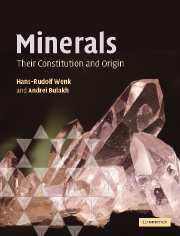Book contents
- Frontmatter
- Contents
- Preface
- Acknowledgments
- Figure credits
- Part I Structural features of minerals
- Part II Physical investigation of minerals
- Part III Variety of minerals and mineral-forming processes
- 14 Classification and names of minerals
- 15 Mineral identification of hand specimens
- 16 Mineral genesis
- 17 Stability of minerals. Principles of thermodynamics
- 18 Solid solutions
- Part IV A systematic look at mineral groups
- Part V Applied mineralogy
- Appendices
- Glossary
- References
- Index
- Plate section
- References
17 - Stability of minerals. Principles of thermodynamics
from Part III - Variety of minerals and mineral-forming processes
- Frontmatter
- Contents
- Preface
- Acknowledgments
- Figure credits
- Part I Structural features of minerals
- Part II Physical investigation of minerals
- Part III Variety of minerals and mineral-forming processes
- 14 Classification and names of minerals
- 15 Mineral identification of hand specimens
- 16 Mineral genesis
- 17 Stability of minerals. Principles of thermodynamics
- 18 Solid solutions
- Part IV A systematic look at mineral groups
- Part V Applied mineralogy
- Appendices
- Glossary
- References
- Index
- Plate section
- References
Summary
Introduction
Minerals form by chemical reactions over a wide range of conditions, with temperature, pressure, and chemical potentials of all components being the most important variables. The principles of thermodynamics, developed in chemistry to quantify chemical transformations, are directly applicable to these reactions. The formal derivation of thermodynamic relationships will not be covered here and it is assumed that the reader has some background in elementary chemistry. Many of the quantitative derivations are not necessary to follow the rest of this book. Yet, at the end of this chapter, a student should be familiar with phase diagrams, and how they are related to the chemical properties of minerals.
We introduce some basic concepts and illustrate them with mineral examples. There are three main laws of thermodynamics that were formulated in the nineteenth century. The first law, based on the recognition by Robert Mayer in 1840 that heat (Δ Q) is equivalent to mechanical work (Δ W), states that a change in the total internal energy of a system (Δ E) is equivalent to the heat transferred into the system minus the work performed by the system; that is, Δ E = Δ Q - Δ W. The total value of internal energy (E) cannot be readily quantified, and in most cases we need to know only how E changes during a process or reaction.
The second law of thermodynamics, proposed by Rudolf Clausius in 1850, can be formulated in several different ways.
- Type
- Chapter
- Information
- MineralsTheir Constitution and Origin, pp. 288 - 304Publisher: Cambridge University PressPrint publication year: 2004



